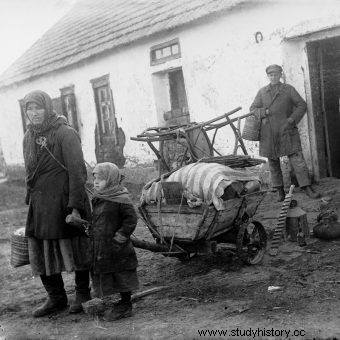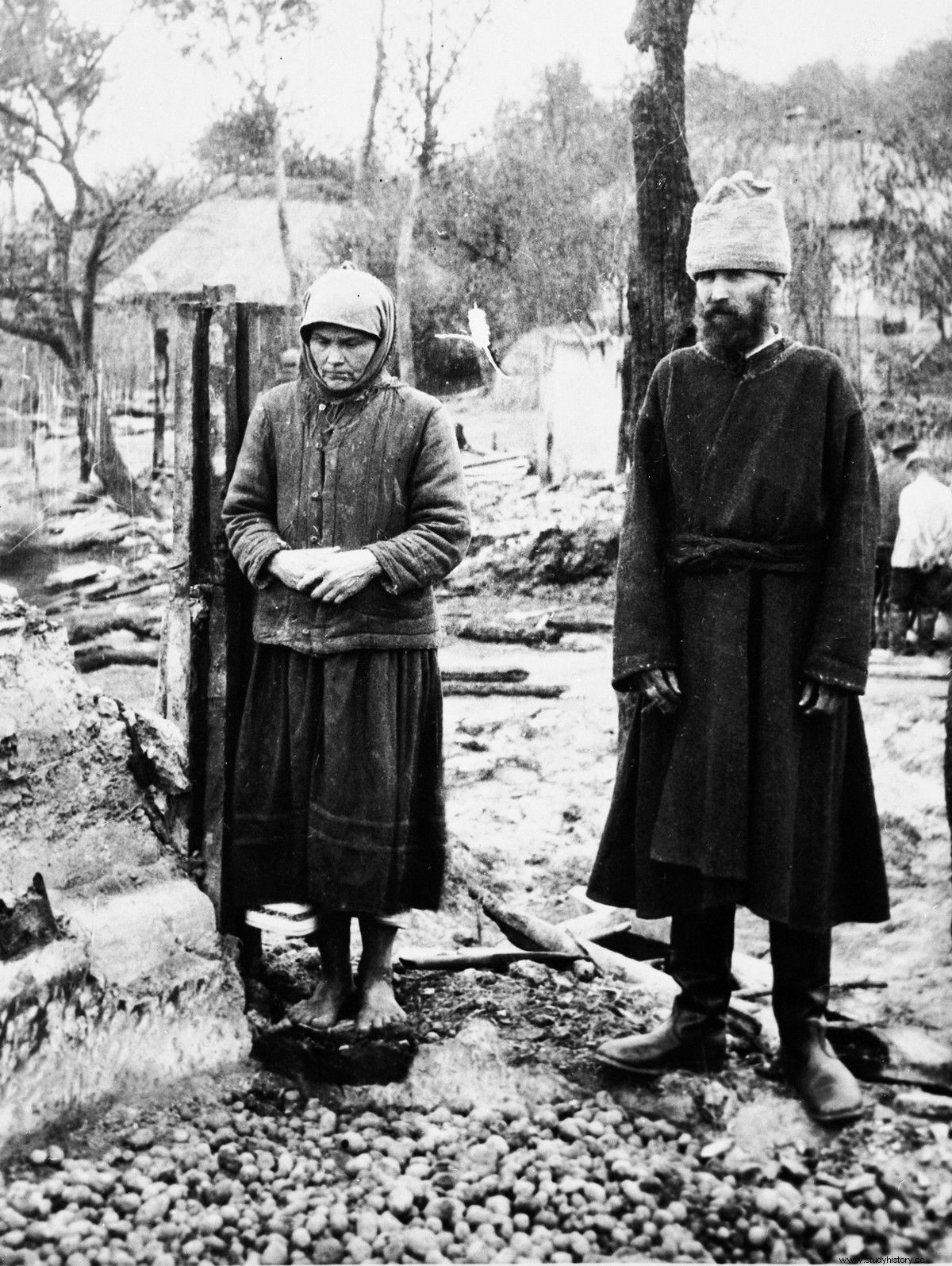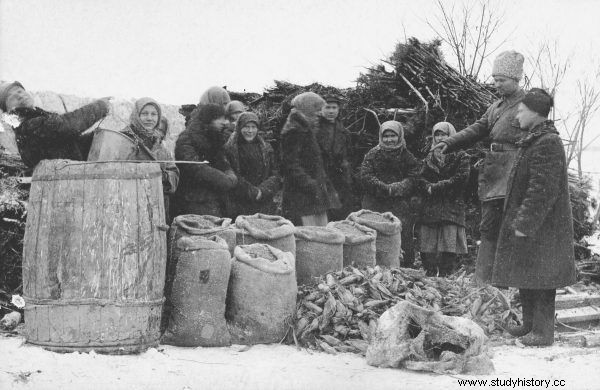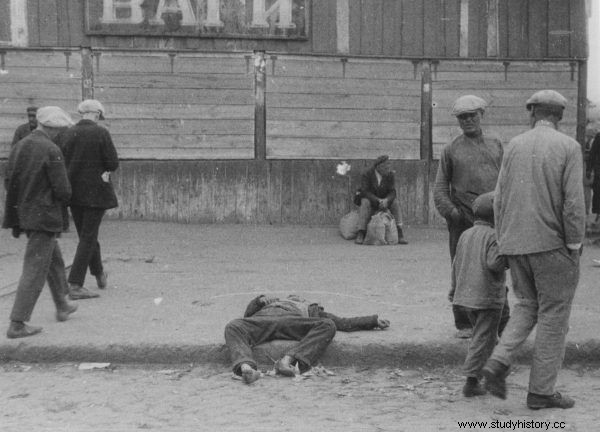It is known that for the Bolsheviks, the revolution was more important than human life. But there is more to their attitude towards this nation than mere contempt. The destruction they had done was driven by sheer hatred. Why were the citizens of this republic prevented from entering the socialist paradise?
The February Revolution toppled tsarism, and the October Revolution brought the Bolsheviks to power. However, when historical changes took place in the empire, its previous parts decided to fight for independence. One of them was Ukraine.

A family of Ukrainian "kulaks" on their way to exile. Photo from the book "Red Hunger".
Despite loud slogans about the self-determination of nations, the Soviets did not intend to agree to it by any means. Even before the revolution, the Bolsheviks disdained the idea of the Ukrainian state. Eventually, the party leaders grew up in the Russian empire, where schools, newspapers and conversations called Ukraine "Lesser Russia" or simply "Southwest Russia".
"Grain, grain, grain!"
The conviction that Ukraine is inextricably linked with Russia was not the only reason why the Red Army moved to Kyiv at the beginning of 1918. Włodzimierz Lenin knew perfectly well that Ukrainian grain deliveries meant "to be or not to be" of the revolution . The Soviet population, and most of all the fighting soldiers, had to be fed.

Lenin realized that the capture of Ukraine would or may not be the Bolshevik revolution.
It was also not without significance that grain exports could provide the communists with an additional source of money. Knowing this, Lenin sent hysterical telegrams to the Ukrainian front:
For God's sake, take the most vigorous and revolutionary steps to ship grain, grain and grain !!! Otherwise, Petrograd may die. Special trains and troops. Harvesting and chute. Trains under guard. Daily reports. For God's sake!
The person responsible for the "supply in southern Russia" was then Joseph Stalin. "We will not regret anyone, neither ourselves nor others, to get the grain" - answered the Bolshevik leader.
Ukraine robbed
Many factors contributed to the famine in Ukraine in 1921-1923:drought, plague of cattle, devastating war ... Mass requisitions of food, brutally enforced by the Bolsheviks, significantly worsened the bad situation. Historians agree that if it were not for them, Ukrainian peasants could largely survive thanks to the accumulated reserves. Unfortunately, having them meant that the person was qualified as a "kulak." And it had the entire Soviet propaganda machine against it.
"Red Army soldiers and Russian agitators (...) went from village to village, looking for the worst off, the least agile, the most opportunistic peasants" - tells Anne Applebaum in the book "Red Hunger". Such people were used to create the so-called kombidy, i.e. committees of poor peasants. They were supposed to help the Bolsheviks by identifying potential victims of the requisition. Thus, the Soviets achieved two goals. They were able to take grain from Ukrainians more efficiently, and in addition they led to a "class struggle" in the Ukrainian countryside, dividing and antagonizing various groups of the peasantry.

The Red Army was sent to requisitioning Ukrainian crops, and the soldiers had no mercy for the peasants.
The requisitions were very brutal, and the attitude of Soviet soldiers towards Ukrainian peasants was marked by contempt and hatred. "The Bolsheviks do not take into account the population at all, they behave as in the occupied territories, in the full sense of the word" - Ensign Stepan Lvivskyj wrote to the head of the Military Commission for Liquidation of the Ukrainian People's Republic in a secret report from December 30, 1920. And he reported:
"I spit on starvation, let 75 percent die. population and not die - we shoot ” - communist Latypov told me - "then 25 percent. will be more humble. We need Ukraine itself, we do not need the population. ”
Gradation of contempt
In the early 1920s, not only Ukraine was starving. Food was scarce in all Soviet republics. Their situation, however, was not the same. Although the Bolsheviks had previously so strongly emphasized that "Malorossia" belonged to the empire, now they ruthlessly took the last grains from starving Ukrainians to give them to starving Russians.
The inequality of the inhabitants of the socialist paradise was confirmed by the Politburo decision of September 1921. It ordered the Ukrainian hunger committee to transfer any remaining "surplus" grain to selected Russian oblasts. In fact, Lenin demanded Ukrainian grain the more severely, the greater the food shortages. In November 1921, explicitly ordered the use of "crude revolutionary methods." As Anne Applebaum writes in her book "Red Hunger" :
Lenin gave clear orders to the requisition committees and commissariats:"In each town, take fifteen to twenty hostages, and if they don't fill the quotas put them against a wall." Should this tactic not bring the desired results, they should be shot as "state enemies".

In the early 1920s, not only Ukraine was starving, but it was this republic that was the target of the most draconian requisitions.
At the same time, when Ukraine was starving, the power was seeping its propaganda. On the streets, posters called for "to help the starving on the Volga", as if only there had been a struggle against defeat. Among the remaining inhabitants of the red empire hatred of the Ukrainians was spread . It was argued that it was the resistance of the Ukrainian kulaks that caused citizens in other parts of the country to swell their bellies, lose their hair and teeth, and cause their loved ones to die slowly, terrible deaths.
Identity erased
Meanwhile, Ukraine was robbed not only of grain, but also of its identity. The Soviets did it extremely cynically. They used the massive wave of hunger, for example, to fight the Church. In 1922, Lenin wrote to Vyacheslav Molotov, then an activist of the Central Committee of the Communist Party (Bolsheviks) of Ukraine, that famine was a unique opportunity to seize church property:
Now and only now, when there is cannibalism in the affected areas, with hundreds, if not thousands of dead bodies lying on the roads, we can (and therefore must) with the greatest and with uncompromising energy to take away church property and to curb any resistance without hesitation. Now and only now the vast majority of peasants will be on our side […].

The Bolsheviks fought fiercely not only with the "kulaks" but also with the Church. The photo shows the dropped church bells in Zhytomyr. A photo from the book "Red Hunger".
Throughout Ukraine, collectivization brigades commandeered icons, golden crosses, and melted church bells. Temples were converted into granaries, for example, or simply destroyed. In the eparchy (the equivalent of the Catholic diocese) of Kiev, where in 1917 there were 1710 churches, only two parishes remained. Almost all the temples built in the Cossack Baroque style specific to Ukrainian culture have disappeared from the face of the earth.
It was not a side effect of fighting religion, but a deliberate action. The Soviets intended to destroy everything that was associated with Ukrainian history and it did not match what was common to Russians and Ukrainians. Among other things, it was decided to completely erase Ukrainianness from the historic capital of "Lesser Russia" - Kiev. As a result, in the second half of the 1930s, several dozen priceless architectural monuments were demolished. Monuments and tombs of Ukrainian literary and political personalities have also disappeared from the city.
The Ukrainian cultural autonomy was also gradually being liquidated. Lenin initially agreed to introduce Ukrainian in schools and offices and to print books and newspapers in this language. He hoped it would help spread Marxism and spread Bolshevik propaganda.
As you can guess, the effect was the opposite. However, the flourishing of Ukrainian culture was soon considered a sign of nationalism that was dangerous to the Soviet government. And the generation of Ukrainian artists and scientists who operated in the 1920s and early 1930s went down in history under the name of "Revival Blasted" .
The extermination of the intelligentsia was accompanied by the extermination of words and ideas. The Bolsheviks systematically joined the latter in the first half of the 1930s. On December 15, 1934, a list of forbidden authors was published, ordering that all their books be removed from libraries, bookstores, educational institutions and warehouses. A total of four such lists were published.
Holodomor. The final solution to the Ukrainian question?
Actions aimed at Ukrainians gained momentum at the turn of the 1920s and 1930s. It began with the fact that on November 10, 1929, the Central Committee in Moscow decided to "accelerate the process of collectivization of rural households." About 25,000 party activists were sent to Ukraine to establish collective farms and convince peasants to join them.

In the years 1930-1933 alone, more than two million Ukrainian peasants were exiled to Siberia. Photo from the book "Red Hunger".
These people did not know and did not understand the village. Steeped in Russian propaganda, they treated the peasants with contempt and suspicion. They believed that the food shortages in the cities were indeed dictated by their reactionary attitudes and greed. And they did not hesitate to take increasingly drastic measures to fulfill the party's plan and punish those who disrupted its implementation.
As a result of their actions, the most resourceful and hardworking peasants were expelled from the Ukrainian countryside. In total, between 1930 and 1933, more than two million Ukrainian peasants were sent to Siberia, northern Russia, Central Asia and other sparsely populated areas of the Soviet Union . Most never came back. In addition, new requisitions have been added. "Mass seizures took place throughout the USSR, but in Ukraine they bordered on fanaticism," says Applebaum in the book "Red Hunger" . The brutality of the communist methods shocked even the Ukrainian correspondent of Pravda. In a private letter to a friend he wrote:
They search usually at night, they search mercilessly, and they search deadly. There is a village right on the Romanian border, where literally in every cottage they smashed the kitchen. (…) They very rarely found any particular quantity; usually searches resulted in the confiscation of the last few breadcrumbs .

All their food was taken from the peasants during the search. Photo from the book "Red Hunger".
The Soviets took not only grain. Farm animals were taken away from peasants, but they had not yet found their way to collective farms. Fruit was harvested from orchards, seeds and vegetables were harvested from home gardens, butter, milk, honey and even whole hives were confiscated. Everything that could be eaten was taken. The last pot of thin soup, the only meal of the whole family, was torn from the hands of the weeping housewives. Sometimes just to spill its contents right outside the hut.
At the same time, in order to protect the remains of collective farm supplies, the law was tightened. The "decree of the five ears of corn", issued on August 7, 1932, made an enemy of the people of anyone who would "steal" a little grain from there . Within five months, under this law, as many as 4.5 thousand people were sentenced to death, and over 100 thousand were sent to labor camps. Sometimes the Soviets patrolling the fields killed hungry Ukrainians on the spot - both men, women and children.
The famine of 1932-1933 hit other parts of the red empire as well. But there is no doubt that the situation of Ukraine was exceptional. "Millions of people wander naked, starving in forests, railway stations, towns and villages in Belarus, begging for a piece of bread" - reported a group of Belarusian workers. They reported that Ukrainians fleeing the areas of disaster have become a real problem. In response, the Soviet authorities introduced ... a system of internal passports, preventing the hungry from leaving the village.

One of the millions of victims of the Holodomor.
The number of victims of the disaster grew at an alarming rate. In January 1933, four hundred corpses were cleared from the streets of Kiev; in February this number increased to 518, and in March, after the first eight days of the month, there were already 248. This is the official data. And yet most of the gathering bodies didn't bother counting. The scale of the drama is clearly demonstrated by the life expectancy of people born in 1933 in Ukraine. For women it was on average 8 years, for men - 5 years.
To this day, it is not known how many people died as a result of the Great Famine. Various researchers point to the numbers from 4 to even 10 million victims . One thing is certain - as a result of the "Holodomor", the Ukrainian national movement completely disappeared from Soviet politics and social life for decades.
